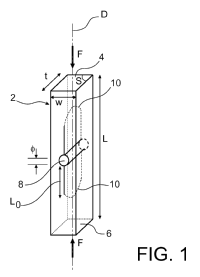Procédé de mesure de la ténacité d'un matériau.
Procédé de mesure de la ténacité Kc d'un comportant les étapes suivantes : – placer un échantillon dudit matériau en forme de parallélépipède rectangle percé en son milieu d'un trou central entre deux mâchoires d'un dispositif de serrage, chacune desdites mâchoires appuyant sur une extrémité éloignée de l'échantillon,
- rapprocher les deux mâchoires de manière à exercer une force à chacune desdites extrémités jusqu'à rupture complète de l'échantillon,
- mesurer pendant le serrage les variations en fonction du temps de la force de serrage exercée à chaque extrémité de l'échantillon,
- déterminer la valeur maximale Fo de ladite force de serrage,
- repérer à la surface d'une des surfaces de rupture trois zones distinctes, soit une première zone à proximité du trou avec un premier type de relief, une deuxième zone avec un deuxième type de relief, et une troisième zone avec un troisième type de relief moins prononcé que le deuxième type,
- mesurer la distance LO entre le bord du trou et une ligne de transition séparant la deuxième de la troisième zone,
- calculer le paramètre Kc en fonction de la force FO et de la distance LO.
Method for measuring the tenacity of a material (WIPO link)
The invention relates to a method for measuring the tenacity Kc of a material, comprising the following steps: placing a sample of said material, having the shape of a parallelepiped rectangle through the middle of which a central hole extends, between two jaws of a clamping device, each of said jaws engaging with a distant end of the sample,
- moving the two jaws together so as to exert a force at each of said ends until the sample has completely broken;
- measuring the variations during the clamping on the basis of the time of the clamping force exerted at each end of the sample;
- determining the maximum value F0 of said clamping force; marking three separate areas on the surface of one of the breaking surfaces,
- i.e. a first area close to the hole having a first type of embossment, a second area having a second type of embossment, and a third area having a third type of embossment that is less pronounced than the second type;
- measuring the distance L0between the edge of the hole and a transition line separating the second area from the third area;
- calculating the parameter Kc on the basis of the force F0 and distance L0..
Contact : Daniel Bonamy.


